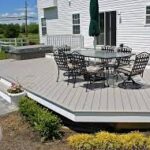The main colors make up the mosque carpet. It can be colored to match the architecture. Color must be acceptable for buildings, not easily dirty, and not distract worshipers.
Mosaic Acrylic Rug
Acrylic Mosques carpet, utilized in new mosques and hot areas, are inexpensive. Synthetic materials are utilized to produce attractive items.
These carpets are easy to clean and dirt-repellent. It doesn’t sweat and can be made to resemble wool carpets, which boosts its popularity.
Acrylic mosque carpets maintain their quality for 25 years on average (climate and usage conditions should also be taken into account). The acrylic rope is used in upholstery, blankets, and garments.
It maintains its first-day state, doesn’t discolor, and doesn’t fade.
Acrylic mosque carpet is odorless and vacuum-cleanable.
Acrylic rope’s durability in weather, light, and sun benefits our consumers. The acrylic thread is stronger than other threads. So, you’ll avoid charges for a long time.
Advantage:
- It’s robust and great for high-traffic locations.
- It’s matt, abrasion, marking, and contamination-resistant.
- Filling and soft. Luxurious.
- It’s insulating.
- It’s fireproof.
Disadvantage:
- This yarn costs extra.
- Cleaning takes care of.
- It’s allergenic.
- Mothproof chemicals must be used.
- Feathering is possible. To remedy this, vacuum it thoroughly.
Wool Moccasin
These carpets are comfy, healthy, and durable. This is why wool mosque rugs are employed in old and new mosques. These carpets are preferred in non-humid climates. Wool mosque carpets insulate sound and heat.
Wool mosque carpet absorbs moisture and moistens arid areas. Wool mosque carpet regulates heat and humidity and resists fire.
Due to their antistatic qualities, wool mosque carpets prevent electricity, absorb radiation, and are readily cleaned.
It has the best insulating characteristics among mosque carpets and can maintain heat year-round. The wool mosque carpet’s vibrant hues will please you visually. As the carpet is durable, so are the colors.
Wool mosque carpet prevents allergies. It prevents lice, fleas, and other microorganisms from reaching the carpet.
Wool mosque carpets are visually appealing and will safeguard your health.
Advantage:
- It’s the closest synthetic to wool.
- Wool-filled and silky.
- It’s sturdy.
- Wool is cheaper.
- It’s felting, abrasion, trace, contamination, mold, moisture, and moth resistant.
- It’s stain-resistant and cleanable.
- It’s less absorbent. Wet flooring is fine.
- It’s sunproof.
Disadvantage:
- Man-made.
- It’s allergenic.
- Feathering is possible. To remedy this, vacuum it.
Polypropylene Mosque Carpet:
- The cheapest yarn.
- It’s a pill-, abrasion-, pollution-, mildew-, moisture-, and moth-resistant.
- Easy to clean, it stains rarely.
- It’s sunproof.
Disadvantage:
- Man-made.
- It’s shorter-lived.
- Quickly seals.
- Heat-resistant.
- Burnt-looking sections indicate wear.
Polyester Mosquito Rug Pros:
- Medium-weight, durable, and flexible.
- It’s soft and bright.
- It’s stain- and fade-resistant, and easy to clean.
Disadvantage:
- Man-made.
- Common pilling.
- High static.
- Low dehumidification makes it hard for water and detergent to remove stains and grime.
Polyamide Mosquito Rug Pros:
- It’s sturdy.
- It resists felting, fuzz, abrasion, staining, dirtiness, mildew, dampness, and moth.
- It’s stain-resistant and cleanable.
Disadvantage:
- Man-made.
- Due to its expensive price and dazzling structure, it’s not utilized in woven carpets but used in tufting carpets.
Center-pattern rugs
When someone mentions mosque carpet patterns, the navel-patterned carpet comes to mind. It’s a mosque carpet. It’s employed in carefully-designed mosques since it doesn’t overpower the design.
This style of the carpet pattern, which has a basic appearance, comprises a pattern constructed according to architecture and measuring 4 to 6 meters in the carpet’s core. Named after its belly pattern.







